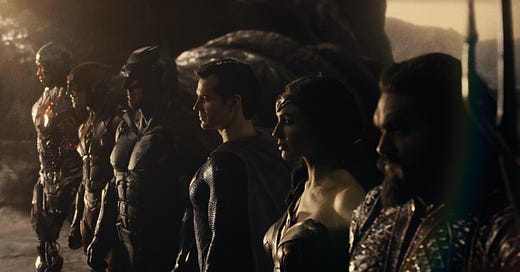Image Credit: Warner Bros.
Welcome to Pop Culture Pick, a catch-all for subjects I want to highlight outside of the usual weekly Weekend Watch columns. In this edition, Zack Snyder takes his shot at Justice League.
It was the director’s cut that, for a long time, few expected to actually happen. Years after Zack Snyder, the one-time architect of the DC Comics Extended Universe on screen, left Justice League during a heart-breaking mix of creative disagreements and family tragedy, he’s now been handed the chance for a massive do-over. One that carries a $70 million price tag. It’s perhaps not hard to see why this might have some appeal for Warner Bros. – following huge fan campaigns and petitions, releasing Snyder’s version generates a huge amount of publicity (much of it free), and drives people towards the company’s HBO Max streaming service. It also feels like paying a debt back to Snyder. The question, though remains: is it worth it for viewers? That’s tougher to judge.
Director’s cuts come in many different forms. Some represent a batch of deleted scenes crammed back into the movie. Others, such as Richard Donner’s cut of Superman II are radically different, the result of the director being replaced, re-edited and then finding a way to put their vision back on to screens, often to the betterment of the film and the delight of fans. Snyder’s Justice League will certainly have its supporters, not least those who have campaigned for its release. For the casual viewer and those who don’t vibe with Snyder’s particular cinematic aesthetic, the film is more likely to be a gruelling slog than a thrilling superhero team-up.
Told across four hours and six chapters, this is a shot of pure Snyder – all darkly-hewed (so dark in places that some might have trouble making out characters among the gloom) sepia-toned melodrama spliced with speed-ramped action scenes that throw everything they can at the screen. Sure, giant battles with crowds of faceless alien baddies have become de rigour in big comic book-based spectacles, but here there’s little to grasp on the character front to give anything real impact or import. Snyder had the money to craft entirely new scenes in CGI, but there are moments that have all the shoddy quality of someone on YouTube standing in front of a cheap green screen. Junkie XL’s score, meanwhile, never succeeds in meshing properly with the scenes, sound out of place. The musical moments that work are legacy themes such as Wonder Woman’s. The dissonance also extends to the characters. Gal Gadot’s Diana Prince is a much more violent fighter than she ever is in her own movies, while smaller characters such as Aquaman’s Vulko (Willem Dafoe) feel like they’ve had a personality transplant. This is certainly Snyder’s dead end, the Extended Universe rolling on without him.
Comparisons to Marvel’s Avengers films might seem unfair, but they’re justified, since this represents a coming together of DC’s heavy hitters. Unlike, say, Avengers: Endgame, the League remains a bit of a mess, feeling rushed in its setup, and full of ideas and concepts that aren’t fully explored. And while Marvel spent time building up the Infinity Stones and establishing the various protagonists and antagonists so that you’re invested in them, here the McGuffins (Mother Boxes at least referenced in Batman V Superman) are the most basic examples of Nasty Tech, and towering threat Darkseid (Ray Porter) relegated to huffily waiting for reports like a boss annoyed by his minions (such as the Ciarán Hinds-voiced Steppenwolf). It doesn’t help that he comes across as a bargain-basement Thanos, sitting on a space-throne while others do his dirty work. Clearly, he was being set up for the sequel that will likely never come. And that’s despite Darkseid appearing before the MCU’s purple nurple in terms of comic book history.
The setup is the only way in which Snyder’s film feels rushed. Otherwise, the strains are clear as it comes across as a story originally designed to be told over different chapters now all mashed together, less than the sum of its parts. Many scenes in the early going feel flabby and languorous, leaving you looking at your watch wondering when things will move along. One addition in particular is more reminiscent of Eurovision Song Contest: The Story Of Fire Saga than a brave, bold heroic story. Until the big action finale kicks in, there’s a lot of dull talk and anguishing over the coming threat. For all its issues (and yes, that allegedly includes Joss Whedon’s attitude), the theatrical cut knows how to move and get the job done in comparison. This is very different in many ways, but has so many of its own issues. Sure, some of the expanded material deepens what happens between the heroes, but it still comes across as unconvincing.
In the positive column? Ezra Miller remains a sparky delight as Barry Allen/The Flash, his quippy asides the few bright spots among the grim attitudes and violence. I was glad to see Snyder give Ray Fisher’s Victor Stone/Cyborg his due at least, and Fisher rises to the occasion, even if the story of a hero with daddy issues is not the most original concept, and it runs on a familiar track. Jeremy Irons’ Alfred is thrown a few entertaining asides and we’re thankfully spared the awful CG ‘tache-removal and rubbery face of Henry Cavill’s Superman, that re-shoot scene completely excised.
Your mileage, as ever, may vary. If you’re a huge Snyder fan (I’ve liked several of his movies, but still remain unsure he was ever right for the DCEU), then you’ve already made up your mind. Otherwise? Be thankful that this is being released on home entertainment formats, where you can take a break if it all gets to be too much.
Zack Snyder’s Justice League will be on HBO Max in the US on 18 March. On the same day, it’ll be available via Sky Cinema/Now TV in the UK.



